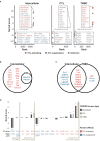Computational Discovery of Cancer Immunotherapy Targets by Intercellular CRISPR Screens
- PMID: 35651625
- PMCID: PMC9149307
- DOI: 10.3389/fimmu.2022.884561
Computational Discovery of Cancer Immunotherapy Targets by Intercellular CRISPR Screens
Abstract
Cancer immunotherapy targets the interplay between immune and cancer cells. In particular, interactions between cytotoxic T lymphocytes (CTLs) and cancer cells, such as PD-1 (PDCD1) binding PD-L1 (CD274), are crucial for cancer cell clearance. However, immune checkpoint inhibitors targeting these interactions are effective only in a subset of patients, requiring the identification of novel immunotherapy targets. Genome-wide clustered regularly interspaced short palindromic repeats (CRISPR) screening in either cancer or immune cells has been employed to discover regulators of immune cell function. However, CRISPR screens in a single cell type complicate the identification of essential intercellular interactions. Further, pooled screening is associated with high noise levels. Herein, we propose intercellular CRISPR screens, a computational approach for the analysis of genome-wide CRISPR screens in every interacting cell type for the discovery of intercellular interactions as immunotherapeutic targets. We used two publicly available genome-wide CRISPR screening datasets obtained while triple-negative breast cancer (TNBC) cells and CTLs were interacting. We analyzed 4825 interactions between 1391 ligands and receptors on TNBC cells and CTLs to evaluate their effects on CTL function. Intercellular CRISPR screens discovered targets of approved drugs, a few of which were not identifiable in single datasets. To evaluate the method's performance, we used data for cytokines and costimulatory molecules as they constitute the majority of immunotherapeutic targets. Combining both CRISPR datasets improved the recall of discovering these genes relative to using single CRISPR datasets over two-fold. Our results indicate that intercellular CRISPR screens can suggest novel immunotherapy targets that are not obtained through individual CRISPR screens. The pipeline can be extended to other cancer and immune cell types to discover important intercellular interactions as potential immunotherapeutic targets.
Keywords: cell-cell communication; cytotoxic T cells; genome-wide CRISPR screen; immune checkpoint inhibitors; intercellular interactions; ligand-receptor interactions; target discovery; triple-negative breast cancer.
Copyright © 2022 Yim, Hwang, Han and Lee.
Conflict of interest statement
NH is a cofounder of KURE.ai and CardiaTec Biosciences and an advisor at Biorelate, Promatix, Standigm, VeraVerse, and Cellaster. The remaining authors declare that the research was conducted in the absence of any commercial or financial relationships that could be construed as a potential conflict of interest.
Figures




Similar articles
-
Systematic Immunotherapy Target Discovery Using Genome-Scale In Vivo CRISPR Screens in CD8 T Cells.Cell. 2019 Aug 22;178(5):1189-1204.e23. doi: 10.1016/j.cell.2019.07.044. Cell. 2019. PMID: 31442407 Free PMC article.
-
In vivo CRISPR screens identify Mga as an immunotherapy target in triple-negative breast cancer.Proc Natl Acad Sci U S A. 2024 Sep 24;121(39):e2406325121. doi: 10.1073/pnas.2406325121. Epub 2024 Sep 19. Proc Natl Acad Sci U S A. 2024. PMID: 39298484 Free PMC article.
-
In vivo multidimensional CRISPR screens identify Lgals2 as an immunotherapy target in triple-negative breast cancer.Sci Adv. 2022 Jul;8(26):eabl8247. doi: 10.1126/sciadv.abl8247. Epub 2022 Jun 29. Sci Adv. 2022. PMID: 35767614 Free PMC article.
-
Systematic review and meta-analysis of genome-wide pooled CRISPR screens to identify host factors involved in influenza A virus infection.J Virol. 2024 May 14;98(5):e0185723. doi: 10.1128/jvi.01857-23. Epub 2024 Apr 3. J Virol. 2024. PMID: 38567969 Free PMC article.
-
Tumor immunology CRISPR screening: present, past, and future.Trends Cancer. 2022 Mar;8(3):210-225. doi: 10.1016/j.trecan.2021.11.009. Epub 2021 Dec 15. Trends Cancer. 2022. PMID: 34920978 Free PMC article. Review.
Cited by
-
CRISPR screens for functional interrogation of immunity.Nat Rev Immunol. 2023 Jun;23(6):363-380. doi: 10.1038/s41577-022-00802-4. Epub 2022 Dec 8. Nat Rev Immunol. 2023. PMID: 36481809 Review.
-
Comparative Analysis of Gene Correlation Networks of Breast Cancer Patients Based on Mutations in TP53.Biomolecules. 2022 Jul 13;12(7):979. doi: 10.3390/biom12070979. Biomolecules. 2022. PMID: 35883535 Free PMC article.
References
Publication types
MeSH terms
LinkOut - more resources
Full Text Sources
Research Materials

